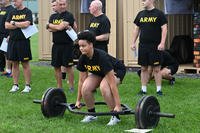As we go through life, it is easy to get busy and neglect certain areas of our lives to focus on another important part of this journey. One of the most common mistakes occurs as we transition away from sports and athletics into work life.
Military personnel can have similar issues as they transition into civilian life. Focus on fitness often is neglected in their new lives.
Letting this neglect become a 10- to 20-year habit can lead to more serious health issues. But even those who make fitness a regular part of their lives still make mistakes that can lead to aches, pains, injuries and even surgeries.
What are some of your biggest training mistakes you have made?
Here is a list of ways many of us have made mistakes throughout our work, military and training lives. Each answer below links to previous articles that may help you with the same issue.
1. Fall Out of Habit
What should you do if you’ve let yourself go after service or college sports and now in middle age need to drop weight and get healthy again (bad blood screening numbers)? This is by far the #1 issue for most Americans asked this question.
It may take a few bad health screenings and a regimen of high blood pressure, cholesterol and blood-sugar medications to convince people to start exercising and eating healthier. It is one thing to fall out of shape, but letting it go too long will get the doctor involved. Most of these prescribed drugs can be avoided by investing just a little time into your own well-being. Treat Yourself Like a Beginner.
2. Getting Started Again
Whether it is after an injury, illness or a prolonged period of inactivity, most start off doing too much, too soon, too fast or lifting too heavy. Doing an old workout like you “used to do” is a recipe for unneeded pain and potential overuse injury.
Getting started again this way typically will cause people to wind up either not recovering properly from a previous injury or require a lot of “recovery days off” because of soreness. Go gentle into training when starting back up.
3. Too Tight
Pay attention to mobility and stretching to maintain the full range of motion. A lack of flexibility and mobility training is something both avid gym goers and individuals who neglect fitness altogether actually have in common.
When muscles and joints are too tight and do not operate with a normal range of motion, you can cause injury through workout movements or just by moving through life. Adding flexibility and mobility training to your life will reward you with less pain, even if you only do it for 10 minutes a day.
4. Ego Lifting
If you spend any time in the weight room, you will know that finding out how much you can lift in any exercise is a natural part of the journey. Too often, chasing the one-rep max (1RM) also can lead to pain, injury, surgeries and poor performance in other areas, like cardio, running tests, swimming streamline and high-rep calisthenics events.
Big numbers in the power or Olympic lifts are fun to chase, but if you also are trying to run fast, “ego lifting” can get in the way and create a huge running (or swimming) weakness.
5. Eating Like You Are Still 20 Years Old
Building mass for the “hard gainers” in their teens and early 20s is a constant challenge that includes eating and supplementing calories in a fashion that is often uncomfortable. Unfortunately, the “if you want to be big, you have to eat big” habit can stay with you for years to a point long after it’s no longer difficult to build mass.
After 30-40 years old, most people start to become “easy gainers” but also a “hard loser.” It becomes more difficult to lose some of the bulk that was easy to burn off 15-20 years earlier. Focus on eating less with smaller portions as you age and keep training regularly. Otherwise, this can become a huge problem.
6. Weather and Performance Matters
Don’t be a heat casualty or a cold casualty. Many people do not plan properly on days when the weather is not ideal. Take the heat, cold, humidity or aridity seriously. Drink enough water and electrolytes and eat recovery meals that will help improve performance numbers in lifts, run times and other events that require an optimal balance of training and recovery.
Recovery matters even more if you’re exposed to serious weather climates, as the results of ignoring it can be deadly. All it takes is one time of becoming a heat casualty suffering from heat exhaustion or heatstroke to learn to plan properly for a long day of exposure to the elements.
7. Keep It Simple
You're going to be frustrated if you try too many gimmicks (supplements, diets, equipment gadgets, etc.) instead of focusing on consistent training, good nutrition and portion control.
Not many people develop “revolutionary” fitness and nutrition products. In the end, it comes down to moving more than you do now and eating better, low-calorie food to lose weight and see improvements in overall health screening and energy levels.
We all make mistakes. Do not be deterred by the errors. Failing and making mistakes is all a part of your success. Hang in there.
Stew Smith is a former Navy SEAL and fitness author certified as a Strength and Conditioning Specialist (CSCS) with the National Strength and Conditioning Association. Visit his Fitness eBook store if you’re looking to start a workout program to create a healthy lifestyle. Send your fitness questions to stew@stewsmith.com.
Want to Learn More About Military Life?
Whether you're thinking of joining the military, looking for fitness and basic training tips, or keeping up with military life and benefits, Military.com has you covered. Subscribe to Military.com to have military news, updates and resources delivered directly to your inbox.

















